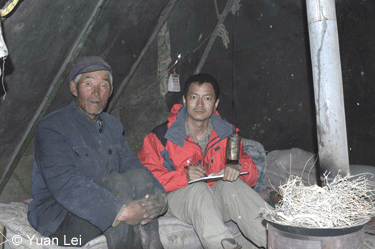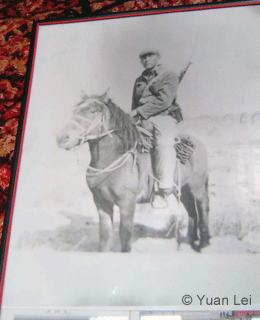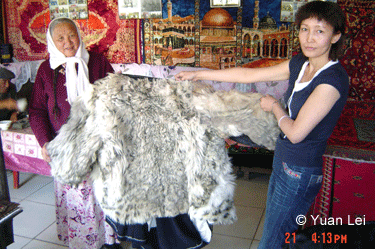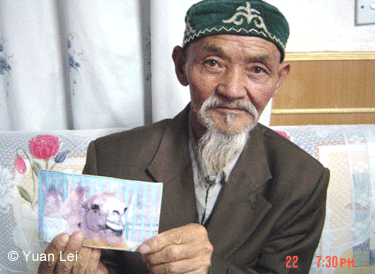Annanba village was chosen as a good site to interview herdsman as this is the only village in the Akesai county that links to, and therefore may influence the Lop Nur Wild Camel National Nature Reserve.
According the China’s policy, herdsman living in the country side should receive money to build houses so they can have the same facilities as people living in the cities. The Akesai county government built many new houses for people in the countryside, resulting in a movement of people from the east edge of the reserve into these newly developed regions. According to Annanba village statistics, there are 56 families living here along with their 98 domestic camels, 6000 goats, 13000 sheep, 164 horses and 25 donkeys. Even though the majority of people moved 120km away from the boundary of the reserve into the new settlement, all of their livestock still graze on the eastern mountain side of the Lop Nur Wild Camel National Nature Reserve.
A survey in 2001 showed the total number of domestic camels to be 197, in 2007 this number has reduced to 98 camels. On average every family has 1-3 domestic camels. These camels were previously used as the sole transport means of moving family tents between summer and winter grass, however due to recent improvements in economic conditions, more people have purchased vehicles. As many people are now using cars instead of camels for transportation, the use and need for camels has drastically decreased, and more and more domestic camels in the Annanba village are being sold or killed for meat.
Grazing areas around Annanba village were divided and distributed to herdsman many years ago. Herdsman have been given the legal land possession for a sum of 50 years, however some herdsman have increased their heads of livestock in recent years and the allotted land is not sufficient for grazing. This results in some herdsman driving their livestock into Xinjiang and the Lop Nur Wild Camel National Nature Reserve.
The Annanba village government is looking into this problem however and trying to find a solution. Plans are underway to build a sheepfold near Akesai county and herdsman are being asked to decrease their number of stock to sustainable levels.
Seven herdsman families were interviewed in the Annanba village to find out why the numbers of domestic camels have dropped over the years. Today herdsman of this area are of two types, those who employ others to help with herding and those who herd their livestock themselves. In Annanba village, a herdsman’s income does not depend on domestic camels and camels are used for transport only. Domestic camels are not herded with the rest of the livestock and are left to graze and forage for themselves, leaving camels to freely wander off, often into the reserve. Camels are only found when they are needed to transport something or are needed for meat, but often camels can be lost forever and some domestic camels integrate into wild camel populations.
Over the years many herdsman have had hybrid camels (offspring of wild and domestic camels). The resulting young are often sold or killed for meat before the age of 3 as after this hybrid camels are hard to control.
A worrying point that came up in many interviews was the fact that 20 years ago many herdsman saw large numbers of wild Bactrian camels. The number of sightings have decreased over the years.
We interviewed a herdsman named Dubaisheng who did not own any grazing land, even though he had over 1000 sheep and goats. Dubaisheng has to travel to far into the reserve in order to find grazing land for his livestock. He does realize that this situation is not good and does want to try and find an alternative, however solutions are hard to find.
The herdsman of Annanba village used to actively hunt. Thirty years ago, the government encouraged herdsman to shoot wolves to protect their livestock. During our interview one herdsman showed us he skin of a snow leopard he had shot. This practice has now become illegal and all herdsman had to hand over their guns to the government.
One of the herdsman we met named Mahemuti caught a male wild camel, fed it for one year and then sold the camel to Shanghai zoo in 1982.
In conclusion, the expedition showed us that because of the huge change in the lifestyle of herdsmen, the domestic value of camels is now much lower. Many herdsman have lost the desire to feed and herd domestic camels, and in doing so have allowed many domestic camels to join wild populations living in the reserve. This has and will greatly affect the DNA of many wild camels.
In addition to the problem of hybridization, both legal and illegal mining is a major problem that affects wildlife living in the Arjin Mountain, especially the wild camel. Mining severely affects the quality and availability of water sources, with many water points drying up and/or having water that is highly contaminated.
This expedition highlighted many serious problems surrounding the survival of the wild Bactrian camel. What we need to do now is to start finding solutions to these problems before it is too late.



